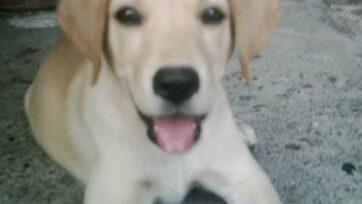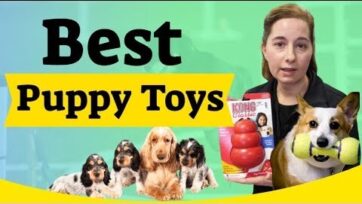All Toys Are Not Equal
Walking down the toy aisle of your local pet supply store can be overwhelming; there are hundreds of toys to choose from. Most people just get whatever looks interesting or at least whatever their dog picks up and slobbers. On today I’m going to show you the four types of toys you should have and how best to use them.
Hey everybody, Ian here with Simpawtico Dog Training. hey before we get to the toy stuff, please make sure you click that “subscribe” button so you never miss any videos, and don’t forget to check the description for notes links and resources about the stuff we talked about. Now, let’s get to it! So, in all things there’s a strategy if you dig a little deeper.
Toys are no different. You can use your toys to develop your relationship, to teach important skills and behaviors and generally make life a lot more fun. To start, understand that dog toys break down into four main categories. They’re chew toys, dental toys, interactive toys and plush toys. The nature’s of these toys is fairly self-explanatory.
Info on how to use these in the smartest ways, however, is not so easily come by. Worry not friends, you’re in good hands. Let’s go over these one at a time: Perhaps the most obvious and ubiquitous category is chew toys. These are designed to be chewed, mangled, punctured, gnawed on, and beat up on a regular basis.
Consequently they are generally made of tough rubber or silicone or even antler, and come in tons of shapes and sizes. Dental toys are also a pretty obvious category. An augmented chew toy of sorts, dental toys are designed to scour teeth, massage gums and promote blood flow. These can be supplemented with doggy toothpaste if necessary, although most of them are designed to work alone.
These have ridges, knobs, fins, and scales on them to work on the dog’s mouth while he or she chews. Some dental toys are in fact fully consumable. With interactive toys we’re now getting into much broader territory. Interactive toys are ones like tug toys, balls, frisbees, retrieval dummies, and variations thereof.
Interactive toys also include puzzles and games. As the name says these are things that your dog interacts with on a higher level than just laying down and chewing. Interactive toys are great because not only do they provide mental stimulation, which is just as important as physical stimulation, but they also offer endless training opportunities.
Every moment with one can be a teachable moment. That’s huge guys, don’t waste it. Finally we get to plush toys. These are primarily stuffed animals and stuffed shapes, although it also includes the stuffingless “flatties.” Generally these kinds of toys look like little animals or cute little characters.
Like the others, they come in an endless array of shapes and sizes for all kinds of dogs. Okay, great. Now we know the classifications, so what the heck do we do with them? Well what ends up happening in most households is that owners by a whole bunch of toys from all four categories and then just go “Here you go, Rover!” All of the toys are available all the time with little to no guidance or supervision.
What a waste of an opportunity. Come on! We can do a lot better than that! Here’s how it works with the categories: chew toys are available all the time. You should have chew toy trained your dog right from the beginning, either as a puppy or as a newly adopted dog. If you have not spent time chew toy training your dog, start now.
Chewing releases endorphins that calm your dog down and produce feelings of contentment. A chew toy trained dog is comfortable being alone and tends to stay out of trouble when they’re unsupervised. Puppies and/or new dogs should initially be fed exclusively via hand feeding or chew toys like a Kong or a Squirrel Dude.
Forget all the fancy recipes you find online and for sure don’t buy any of that cheese whiz looking crap made to fill chew toys. Instead use their normal food. Measure it out, moisten it, and freeze it. Now its on demand and convenient. Leave them with food when you leave the house. Use food-filled chew toys when you must attend other things.
Tie food-filled chew toys to the insides of crates to facilitate crate training. Tie them to trees in the yard during summer time for outdoor fun. Since you’re using their normal food, you’re keeping their nutrition balanced. You’re not glutting them with treats, which should ideally only be about ten percent of their daily caloric intake.
You’re also empowering their food to be a training reward all by itself. You can use dog food to train your dog and save the treats for jackpots. Ultimately a food-filled chew toy will create train a dog ultra fast. This makes potty training and overall management a breeze. It also trains the dog to enjoy time alone, circumventing the destructive behaviors associated with boredom or isolation distress, which is commonly mistaken for separation anxiety.
Heck, even true separation anxiety can be mitigated to some extent with strategic chew toy training. Regular chew toys also make great coping methods for high stress or arousal; train your dog to funnel excitement and energy into a chew toy. Now, dental toys can be left out to for the most part. The exception to that would be if you plan to use a toothpaste with it in which case they’re brought out at regular intervals to temporarily replace a regular chew toy.
These should be supervised when toothpaste is involved and of course cleaned afterwards. Also dental toys should be checked after each use. If any of the massaging studs or fins start to come off, the toy should be retired. All chew toys for that matter should be regularly inspected and retired when they get too small or too mangled.
Interactive toys are only brought out when a play session is initiated by you. You keep them put away and you decide what game to play and when. Your dog may have favorites, and that’s great, but he shouldn’t have free access to the interactive toys. By controlling access you can leverage the toy and the activity as training rewards.
Training doesn’t always have to be done with treats. In fact, toys are a gateway to phasing out treats all together. You then also use the games and activities to teach behaviours to your dog. For example, tug is an awesome game. Look if a well-meaning neighbor or pet store trainer tells you to never play tug with your dog because it’s dangerous, please think them and walk away.
That is complete rubbish. As with all games with your dog, tug is a great opportunity for learning and bonding. You just have to start out by teaching the rules. Playing tug with a puppy is one of those activities that helps to develop a soft mouth. It goes along with the bite inhibition training that we do in the off-leash puppy classes, and every dog should know Take It and Drop It, two important and very basic commands.
Incidentally interactive toys are a fantastic way to do just that. Dog toys without squeakers are the best. Most dogs really go bonkers with squeakers, but a squeaker can trigger higher levels of arousal and encourage them to dissect the toy to get it, which is a bad habit. We don’t need our dogs to find that activity fun and start dissecting the mail and your purse, or to go after other things that squeak like the neighbor’s chihuahua, a kitten or your guinea pig.
Finally plush toys. These are the most misunderstood and misused category of them all. Many owners buy these for their dogs and allow them to destroy them. Guys, this is wrong. Not only are you missing out on a tremendous learning opportunity, but you’re also training your dog to tear apart other things they find, like slippers and wallets.
A dog should never destroy one of these toys. In fact, a $1.99 plush toy should ostensibly last indefinitely. Your chew toys and interactive toys should get all the wear and tear; the plush toys are for teaching. A really good play and learning session I’ve used in the past uses an interactive toy and a plush toy, and it goes like this: The tug toy comes out first.
The dog can’t have it until we say “Take it.” And we play tug for a minute or so. This is a great time to teach game manners and rules like, “Don’t ever accidentally get me with your teeth.” Now we use “drop it.” Teach it, reinstruct it, reinforce it. The tug toy goes away and the plush toy comes out.
Here’s where things get interesting. we squeak it and treat it like a baby in our hands. We treat it like it’s alive. We want softness and kindness toward it. Any grab, bite or tug gets a “Hey! What have you done?! You’ve hurt Mr. Toy!” See, this is a violation of the take it rule.
That is to say, the dog can’t take it in her mouth unless and until we okay it. It also shows you the difference between what you think the boundaries are and put your dog thinks they are. Very often there’s a disconnect there. This is where we step up, and bridge that gap. If they grabbed for it or if their drop it is sloppy, then we have a five-second instructive time out in a Down stay.
Now the plush toy goes away and we repeat the cycle a few times. So, the interactive toy comes out again and we use tug as a reward for being nice to the plush toy. Play this game between five and ten minutes. When you’re all done say, “All done, thank you!” and put the toys away. Remember, access is restricted to these toys to only times when games are being played with you.
Don’t forget to praise enthusiastically for every good thing. Reinstruct for slow responses. Repeat exercises and have high expectations. Treats are not necessary here because the rewards are intrinsic–they’re built into the activity. And for that to work this it’s got to be fun, so relax and make learning part of your fun.
It will pay off huge down the road. I mean look, imagine if you had other small animals in the house, a guinea pig or a bearded dragon, or imagine if you had a new baby or one came to visit or maybe your cat has kittens or maybe you messed up your knee and you just need rover to take it easy around you for the next few weeks.
That’s what these activities are for. Understanding how best to capitalize on these toys and their categories can help you develop a lot of healthy dog behavior and build a rock solid bond. So there you go, fellow dog lovers. Thank you for watching, don’t forget to subscribe to my channel, thumbs up this video, and connect with me in the comments about how you use toys in your home.
Check the description for notes and resources, and until next time keep learning, keep practicing and i’ll see you soon.
Source Link: https://www.youtube.com/watch?v=Ht8ncX4Kq7M


